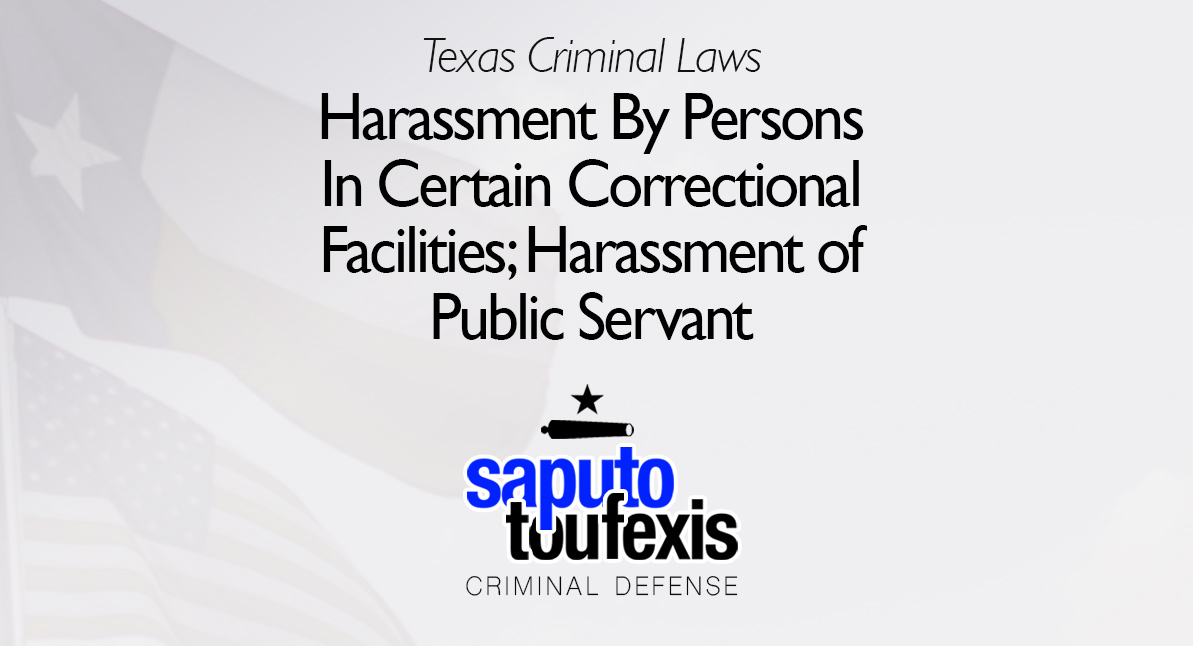The Harassment By Persons In Certain Facilities; Harassment Of Public Servant law in the state of Texas makes it illegal for anyone to cause a public servant to come in contact with their blood, urine, or any other body fluid with the intent to assault, harass, or alarm.
FAQs about the
Harassment By Persons In Certain Facilities; Harassment Of Public Servant law in Texas
- What is the current Texas law about Harassment By Persons In Certain Facilities; Harassment Of Public Servant?
- What changed in 2017?
- How can I be charged with an Harassment By Persons In Certain Facilities; Harassment Of Public Servant offense in Texas?
- What is the statute of limitation for Harassment By Persons In Certain Facilities; Harassment Of Public Servant in Texas?
- What is the penalty for a Texas Harassment By Persons In Certain Facilities; Harassment Of Public Servant offense?
- Can you get probation for Harassment By Persons In Certain Facilities; Harassment Of Public Servant in Texas?
- Do I have to register as a sex offender in Texas if guilty of Harassment By Persons In Certain Facilities; Harassment Of Public Servant?
- What level of crime is Harassment By Persons In Certain Facilities; Harassment Of Public Servant in Texas?
The law also makes it illegal for prisoners at a correctional facility or civil committment facility to cause someone else in the facility to come in contact with their blood, urine, or any other body fluids with the intent to assault, harass, or alarm.
Have you been charged with Harassment By Persons In Certain Facilities; Harassment Of Public Servant? Contact us today to discuss legal representation.
or Text or Call (888) 239-9305
The Texas legislature codified this criminal offense in Texas Penal Code Section 22.11. The law was not amended in 2023. However, the law was most recently amended in 2017 by expanding the application of the law to civil commitment facilities.
The Penal Code classifies the Texas Harassment By Persons In Certain Facilities; Harassment Of Public Servant law under Title 5 “Offenses Against The Person,” Chapter 22 “Assaultive Offenses.” Learn more about the Texas offense of Harassment By Persons In Certain Facilities; Harassment Of Public Servant below.
What is the current Texas law about Harassment By Persons In Certain Facilities; Harassment Of Public Servant?
Texas law currently defines the offense of Harassment By Persons In Certain Facilities; Harassment Of Public Servant in Penal Code Section §22.11 as follows:[1]
(a) A person commits an offense if, with the intent to assault, harass, or alarm, the person:
(1) while imprisoned or confined in a correctional or detention facility, causes another person to contact the blood, seminal fluid, vaginal fluid, saliva, urine, or feces of the actor, any other person, or an animal;
(2) while committed to a civil commitment facility, causes:
(A) an officer or employee of the Texas Civil Commitment Office to contact the blood, seminal fluid, vaginal fluid, saliva, urine, or feces of the actor, any other person, or an animal:
(i) while the officer or employee is lawfully discharging an official duty at a civil commitment facility; or
(ii) in retaliation for or on account of an exercise of official power or performance of an official duty by the officer or employee; or
(B) a person who contracts with the state to perform a service in the facility or an employee of that person to contact the blood, seminal fluid, vaginal fluid, saliva, urine, or feces of the actor, any other person, or an animal:
(i) while the person or employee is engaged in performing a service within the scope of the contract, if the actor knows the person or employee is authorized by the state to provide the service; or
(ii) in retaliation for or on account of the person’s or employee’s performance of a service within the scope of the contract; or
(3) causes another person the actor knows to be a public servant to contact the blood, seminal fluid, vaginal fluid, saliva, urine, or feces of the actor, any other person, or an animal while the public servant is lawfully discharging an official duty or in retaliation or on account of an exercise of the public servant’s official power or performance of an official duty.
What changed in 2017?
In 2017, the legislature created a subsection (2) of this offense, which added inmates of civil commitment facilities to the group of people that can commit this offense.[2]
How can I be charged with an Harassment By Persons In Certain Facilities; Harassment Of Public Servant offense in Texas?
You can be charged with Harassment by Persons in Certain Correctional Facilities; Harassment of Public Servant in Texas if the state’s attorneys believe that each of the elements of 22.11(a) as described in the section above have been met.
What is the statute of limitation for Harassment By Persons In Certain Facilities; Harassment Of Public Servant in Texas?
Harassment By Persons In Certain Facilities; Harassment Of Public Servant offenses have a three-year limitations period.[3]
What is the penalty for a Texas Harassment By Persons In Certain Facilities; Harassment Of Public Servant offense?
Violations of this law are punished as a third degree felonies,[4] with a maximum possible fine under Texas state law of up to $10,000 and prison time of up to 10 years.
Can you get probation for Harassment By Persons In Certain Facilities; Harassment Of Public Servant in Texas?
The Texas Code of Criminal Procedure allows both judges and juries to grant probation for Harassment By Persons In Certain Facilities; Harassment Of Public Servant, and judges are also allowed to accept deferred adjudication plea deals.[5]
Note, however, that no matter the offense, neither judges nor juries may recommend community supervision for any suspended sentence of over 10 years.[6] Also, judges may not grant community supervision after a conviction if (1) the defendant used or exhibited a deadly weapon during the commission of the felony or immediate flight thereafter and (2) the defendant used or exhibited the deadly weapon himself or was a party to the offense and knew that a deadly weapon would be used or exhibited.[7]
Do I have to register as a sex offender in Texas if guilty of Harassment By Persons In Certain Facilities; Harassment Of Public Servant?
The Harassment By Persons In Certain Facilities; Harassment Of Public Servant offense does not appear on the list of offenses requiring registration under Chapter 62 of the Texas Code of Criminal Procedure.[8]
However, the legislature can add this offense to the list at any time. If that happens, people convicted of Harassment By Persons In Certain Facilities; Harassment Of Public Servant would have to register, even if the offense did not appear on the list at the time they accepted a deferred adjudication plea (even if later dismissed), pled guilty or were founty guilty.
What level of crime is Harassment By Persons In Certain Facilities; Harassment Of Public Servant in Texas?
The Penal Code classifies the punishment for Harassment By Persons In Certain Facilities; Harassment Of Public Servant as a third degree felony.
Learn more about the penalty range for this offense in the section above.
Legal References:
^1. Texas Penal Code §22.11. This law is current as of 2024.^2. SB 1576, 85th Legislature, Section 29^3. See Code of Criminal Procedure 12.01(9)^4. Texas Penal Code §22.11(b)^5. See Chapter 42, Texas Code of Criminal Procedure, Art. 42A.054, Art. 42A.056, Art. 42A.102^6. Art. 42A.053(c), Texas Code of Criminal Procedure^7. Art. 42A.054(b), Texas Code of Criminal Procedure^8. Code of Criminal Procedure, Article 62.001










